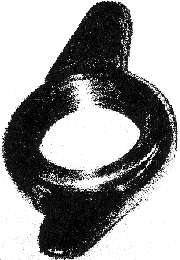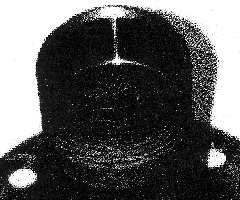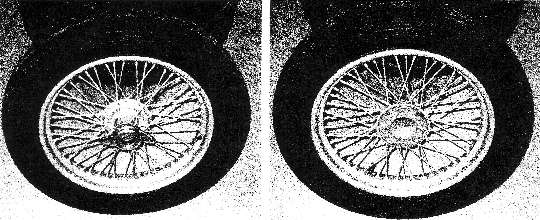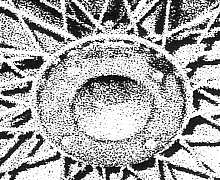The MGA With An Attitude
BALANCING WIRE WHEELS - Adapter - WL-110A
Wire Wheel Spin Balance Adapter by Corky Guenther (T Party times)
The article is for the TC, but the information is applicable to all vehicles with wire wheels. One only has to get the proper hub to make up the adapter.
I think that 19" wire wheels are part of the essence of the MGTC. They're a major part of the visual impact the car projects. It's also true that they are a bit of a headache when unbalanced. Particularly if the car is regularly driven long distances at highway speeds. With tire prices continually rising, it is desirable to keep them balanced to obtain the maximum life from each set. The problem I've found is that bubble balancing even when done by the "professionals" seems to be an inexact science (art?). Also, modern spin balancing machines don't provide a mounting method for the center lock wheels which require seating on the inside diameter of the inside face (cone) of the hub and the outside diameter at the outside (knock off) end of the hub.

My solution is courtesy of the folks at Triumph. My daily driver for a number of years was a TR-3. It had disc wheels when I bought it and I wanted wires. I soon discovered that this was easily accomplished by doing what the factory did. Bolt on a set of adapters, and mount the wire wheels. It took 40 minutes tops. You are supposed to shorten the studs but I didn't have to. Try that conversion with your MG.

 To make the balancing adapter, I obtained a used TR-2/6 wire wheel adapter (hub extension) by posting a request to an on-line Triumph mailing list. For this application, splines are not really required so any condition is acceptable (cheap too). I took the adapter along with an old knock off (must be coarse thread) to my local machine shop. They machined the ID of the adapter (see picture 1) to clean it up and make it concentric with the OD of the adapter (see drawing and picture). They also bored out the center of the knockoff to the OD of the adapter threads (see pictures 2 and 3).
To make the balancing adapter, I obtained a used TR-2/6 wire wheel adapter (hub extension) by posting a request to an on-line Triumph mailing list. For this application, splines are not really required so any condition is acceptable (cheap too). I took the adapter along with an old knock off (must be coarse thread) to my local machine shop. They machined the ID of the adapter (see picture 1) to clean it up and make it concentric with the OD of the adapter (see drawing and picture). They also bored out the center of the knockoff to the OD of the adapter threads (see pictures 2 and 3).
To balance, mount the wheel on the hub adapter with the modified knockoff and then mount the wheel/adapter assembly on the balancing machine. For the 19" rims of the TC, this does require that the balancing machine have the ability to set (measure) the diameter of the rim and the offset of the inner and outer rim surfaces where the weights are mounted. The hub adapter flange will seat on the face of the balancer and a tapered cone is used on the knock off end of the hub, contacting the ID of the adapter. Then spin as usual. Adhesive backed weights make attachment easy and the result is a set of wheels and tires balanced both statically and dynamically.

 
Note: I have subsequently discovered that since my TC wheels are somewhat "wobbly" trying to dynamically balance them resulted in great quantities of weight being added to the wheels. Generally this was to the inside and the outside of the rim in locations diametrically opposed. Presumably, this is because all of the weight added is very close to the centerline of the wheel. Consequently, I have the shop just do a static balance (the machine indicates the static and dynamic components separately). The result has been significantly less weight than that added by the aforementioned professionals with a bubble balancer and significantly less tire wear. Also, no wheel shimmy at any speed up to 70-75 MPH.
The adapter will work for any of the Dunlop wire wheels fitted to the T-Series and other British cars using the same hub.
Daton Wire Wheels hubs made after 1990 are fully machined so an internal alignment cone can be used on the outer end. For details see
http://www.daytonwirewheel.com/pdf/balancinginstructionsforspline.pdf
|


 To make the balancing adapter, I obtained a used TR-2/6 wire wheel adapter (hub extension) by posting a request to an on-line Triumph mailing list. For this application, splines are not really required so any condition is acceptable (cheap too). I took the adapter along with an old knock off (must be coarse thread) to my local machine shop. They machined the ID of the adapter (see picture 1) to clean it up and make it concentric with the OD of the adapter (see drawing and picture). They also bored out the center of the knockoff to the OD of the adapter threads (see pictures 2 and 3).
To make the balancing adapter, I obtained a used TR-2/6 wire wheel adapter (hub extension) by posting a request to an on-line Triumph mailing list. For this application, splines are not really required so any condition is acceptable (cheap too). I took the adapter along with an old knock off (must be coarse thread) to my local machine shop. They machined the ID of the adapter (see picture 1) to clean it up and make it concentric with the OD of the adapter (see drawing and picture). They also bored out the center of the knockoff to the OD of the adapter threads (see pictures 2 and 3). 

